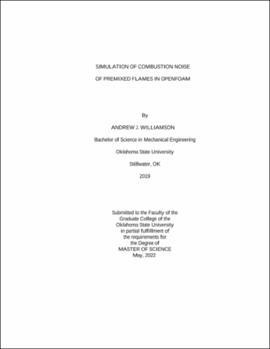| dc.contributor.advisor | Sallam, Khaled | |
| dc.contributor.author | Williamson, Andrew J. | |
| dc.date.accessioned | 2023-04-03T20:51:44Z | |
| dc.date.available | 2023-04-03T20:51:44Z | |
| dc.date.issued | 2022-05 | |
| dc.identifier.uri | https://hdl.handle.net/11244/337245 | |
| dc.description.abstract | Advancements in combustion which have increased efficiency and reduced greenhouse gas emissions, such as premixed combustion and lean injection, have led to increased noise emission due to higher turbulence and mixing fluctuations. This study explored the viability of a hybrid CFD and acoustic analogy method for simulating noise in residential furnaces. This was done by exploring the validity of various chemical mechanisms to reduce computational time requirements, validating the acoustic analogy in enclosed spaces with an expansion chamber silencer, and finally testing the method on a laboratory scale furnace geometry. The WD2, SG35, Z42, DRM22 and GRI-3.0 combustion mechanisms were compared against the experimental data of the Sandia D Flame. The computational cost of these mechanisms had a power relation to the number reaction as predicted by theory, except for the global mechanism which performed worse than both the skeletal mechanisms. The libAcoustics library and Ffwocs-Williams Hawkings (FWH) acoustic analogy was validated for confined flow using the expansion chamber silencer and plane wave-theory. The calculated transmission loss compared well with the plane-wave theory and the sine-sweep method was determined to be an effective method for simulating the acoustic source. Larger time steps smoothed the sound pressure level (SPL) frequency spectrum, but this did not result in a significantly depressed the overall sound pressure level (OASPL). A laboratory scale furnace was built, and the SPL frequency spectrum was measured with SPL meter and microphones. The equivalence ratio and ramping the flow rate did not significantly alter the SPL spectrum or OASPL. However, the flow rate had a linear relationship with the SPL amplitude and peak frequencies. A simulation of the laboratory scale furnace was performed using both LES and URANS turbulence modeling. The LES-FWH simulation of the furnace predicted the combustion peak frequency and amplitude, and the OASPL. The URANS simulation underpredicted the amplitude of the SPL spectrum. | |
| dc.format | application/pdf | |
| dc.language | en_US | |
| dc.rights | Copyright is held by the author who has granted the Oklahoma State University Library the non-exclusive right to share this material in its institutional repository. Contact Digital Library Services at lib-dls@okstate.edu or 405-744-9161 for the permission policy on the use, reproduction or distribution of this material. | |
| dc.title | Simulation of combustion noise of premixed flames in OpenFOAM | |
| dc.contributor.committeeMember | Elbing, Brian | |
| dc.contributor.committeeMember | San, Omer | |
| osu.filename | Williamson_okstate_0664M_17630.pdf | |
| osu.accesstype | Open Access | |
| dc.type.genre | Thesis | |
| dc.type.material | Text | |
| dc.subject.keywords | acoustic analogy | |
| dc.subject.keywords | chemical mechanism | |
| dc.subject.keywords | combustion | |
| dc.subject.keywords | OpenFOAM | |
| thesis.degree.discipline | Mechanical & Aerospace Engineering | |
| thesis.degree.grantor | Oklahoma State University | |
